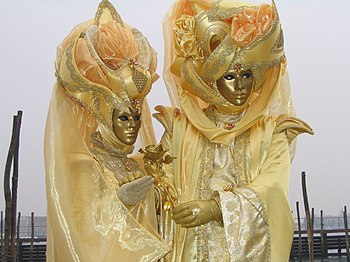The Carnival of Venice (Italian: Carnevale di Venezia) is an annual festival, held in Venice, Italy. The Carnival starts 40 days before Easter and ends on Shrove Tuesday (Fat Tuesday or Martedì Grasso), the day before Ash Wednesday.
History
Carnival started as a time for celebration and expression throughout the classes, as wearing masks hid any form of identity between social classes. During the 1970s, the Italian government decided to bring back the history and culture of Venice, and sought to use the traditional Carnival as the centerpiece of their efforts. Today, approximately 3,000,000 visitors come to Venice each day for Carnivals. One of the most important events is the contest for the best mask, placed at the last weekend of the Carnival. A jury of international costume and fashion designers votes for "La Maschera piu bella". Here are the first prize winners of the last years:
- 2011 : "La Famille Fabergé" by Horst Raack, shared with "Omaggio a Venezia" by Paolo and Cinzia Pagliasso and Anna Rotonai,also the first prize for the special category 19th century to Lea Luongsoredju and Roudi Verbaanderd from Belgium
- 2010 : "Pantegane" from Great Britain
- 2009 : "The Voyages of Marco Polo" by Horst Raack and Tanja Schulz-Hess from Germany[1]
[edit]Venetian carnival masks
Masks have always been a central feature of the Venetian carnival; traditionally people were allowed to wear them between the festival of Santo Stefano (St. Stephen's Day, December 26) and the start of the carnival season and midnight of Shrove Tuesday. They have always been around Venice. As masks were also allowed on Ascension and from October 5 toChristmas, people could spend a large proportion of the year in disguise[1]. Maskmakers (mascherari) enjoyed a special position in society, with their own laws and their own guild.
Venetian masks can be made in leather or with the original glass technique. The original masks were rather simple in design and decoration and often had a symbolic and practical function.[2] Nowadays, most of them are made with the application of gesso and gold leaf and are all hand-painted using natural feathers and gems to decorate.
[edit]Bauta
Bauta(sometimes referred to as baùtta) is the whole face, with a stubborn chin line, no mouth, and lots of "gilding". One may find masks sold as Bautas that cover only the upper part of the face from the forehead to the nose and upper cheeks, thereby concealing identity but enabling the wearer to talk and eat or drink easily. It tends to be the main type of mask worn during the Carnival. It was used also on many other occasions as a device for hiding the wearer's identity and social status. It would permit the wearer to act more freely in cases where he or she wanted to interact with other members of the society outside the bounds of identity and everyday convention. It was thus useful for a variety of purposes, some of them illicit or criminal, others just personal, such as romantic encounters.
In 18th century, the Bauta had become a standardized society mask and disguise regulated by the Venetian government.[3][4] It was obligatory to wear it at certain political decision-making events when all citizens were required to act anonymously. Only citizens had the right to use the Bauta. Its role was similar to the anonymizing processes invented to guarantee general, direct, free, equal and secret ballots in modern democracies.
It was not allowed to wear weapons along with the mask, and police had the right to enforce this ruling.
[edit]Volto or Larva
The "Volto" was the more common mask used in Venice for centuries. Volto means "face", and it was the simplest mask to produce.
[edit]Mask-makers
The mascherari, or mask-makers had their own statute dated 10 April 1436. They belonged to the fringe of painters and were helped in their task by sign-painters who drew faces onto plaster in a range of different shapes and paying extreme attention to detail.
Venetian masks feature prominently in the film Eyes Wide Shut. In the film, the main character (played by Tom Cruise) infiltrates a masked ball where high ranking individuals engage in secret orgies and masonic rituals. Stores that supplied the masks include both Ca’ Macana[5]and Il Canovaccio[6] in Venice. The latter displays the original mask worn in the film by Tom Cruise on their website.
[edit]Cultural References
Carnevale is depicted in the 2009 video game Assassin's Creed II. The main character, Ezio Auditore, is assisted by the artist Leonardo da Vinci in hunting down and assassinating the corrupt Doge of Venice during Carnevale; a golden mask, which Ezio must obtain to enter a private party held by the Doge, plays a significant role in this part of the game.
Source: http://en.wikipedia.org/wiki/Venice_Carnival





No comments:
Post a Comment